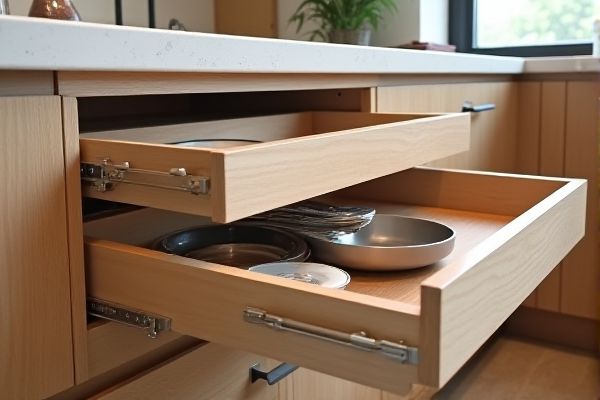
Deep drawers provide ample storage space for bulky items, while shallow drawers offer easy access to smaller essentials and better organization. Discover which drawer type suits Your needs best by reading the rest of the article.
Table of Comparison
| Feature | Deep Drawers | Shallow Drawers |
|---|---|---|
| Storage Capacity | High - stores bulky and tall items easily | Low - best for small, flat items |
| Organization | Flexible but can become cluttered | Better for neat, compartmentalized storage |
| Accessibility | May require bending and reaching | Easy to access items quickly |
| Use Cases | Kitchen pots, pans, large tools, files | Utensils, stationery, small clothing items |
| Installation Space | Requires more vertical space | Suitable for limited depth areas |
| Cost | Generally higher due to size | Usually lower and more affordable |
Introduction to Drawer Depths
Deep drawers offer substantial storage capacity, ideal for bulky items like pots, pans, and large kitchen utensils, while shallow drawers provide easy access and organization for smaller items such as cutlery and office supplies. Choosing the appropriate drawer depth depends on the intended use, with deep drawers maximizing vertical space and shallow drawers enhancing visibility and quick retrieval. Effective storage solutions often combine both depths to balance accessibility and volume in residential or commercial settings.
Key Differences: Deep vs Shallow Drawers
Deep drawers offer increased storage capacity, ideal for bulky items such as pots, pans, or large kitchen utensils, while shallow drawers provide easy access and organization for smaller items like cutlery, spices, or office supplies. Material thickness and drawer slide mechanisms often vary, with deep drawers requiring sturdier slides for heavier loads compared to the lighter hardware suitable for shallow drawers. The choice between deep and shallow drawers impacts overall kitchen or workspace efficiency by balancing storage volume against quick accessibility and organization.
Advantages of Deep Drawers
Deep drawers offer significant storage capacity, making them ideal for organizing bulky items such as pots, pans, and large kitchen appliances. Their spacious design reduces clutter by accommodating more items in a single compartment, enhancing overall kitchen efficiency. You benefit from easy access and better visibility for heavier or larger items compared to shallow drawers.
Advantages of Shallow Drawers
Shallow drawers offer enhanced organization and easy access to frequently used items, making them ideal for storing utensils, office supplies, or small tools. Their limited depth prevents clutter accumulation, allowing for quick visibility and retrieval of contents. This design optimizes space efficiency in both kitchens and workspaces by keeping essentials neatly arranged and readily accessible.
Best Uses for Deep Drawers
Deep drawers are ideal for storing bulky items such as pots, pans, large kitchen appliances, or stacks of clothing, maximizing vertical space efficiently. Their spacious design helps keep your kitchen or wardrobe organized by accommodating items that shallow drawers cannot, reducing clutter. You can enhance accessibility and storage capacity by choosing deep drawers for frequently used heavy or oversized belongings.
Ideal Applications for Shallow Drawers
Shallow drawers are ideal for organizing small items such as cutlery, stationery, and makeup, providing easy visibility and quick access. They work best in kitchens, offices, and bathrooms where compartmentalization of various tools or accessories is essential. Their limited depth prevents clutter and ensures that frequently used items remain neatly arranged and accessible.
Storage Capacity Comparison
Deep drawers offer significantly more storage capacity than shallow drawers, making them ideal for bulky items such as pots, pans, and large kitchen tools. Shallow drawers, while limited in height, provide better organization for smaller items like utensils, spices, or office supplies, allowing easy access without wasted space. Choosing deep drawers increases overall storage potential, but your specific needs will determine the best combination for efficient use of available space.
Organization and Accessibility
Deep drawers offer increased storage capacity, making them ideal for organizing bulky items or larger kitchenware, but can make accessing items at the bottom more challenging without proper dividers. Shallow drawers enhance accessibility by keeping contents visible and within easy reach, perfect for organizing smaller utensils and frequently used items. Incorporating customizable inserts in both drawer types maximizes organization and improves overall functionality in any space.
Design Considerations for Drawers
Deep drawers offer ample storage for bulky items and are ideal for maximizing vertical space, while shallow drawers provide easy access and better organization for smaller items. When designing drawers, consider the intended function, weight capacity, and ease of access to optimize usability and aesthetics. Your choice should balance storage needs with the overall design flow of the furniture or cabinetry.
Choosing the Right Drawer Depth for Your Needs
Deep drawers offer increased storage capacity ideal for bulky items or large kitchenware, maximizing space efficiency in modern cabinetry. Shallow drawers provide easy access and organization for smaller items like utensils and tools, enhancing convenience and visibility. Selecting the proper drawer depth depends on item size, frequency of use, and overall kitchen layout to optimize functionality.
 homyna.com
homyna.com